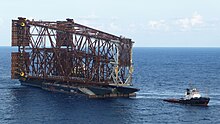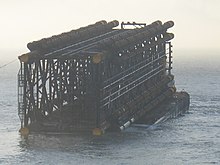
A lattice tower or truss tower is a freestanding vertical framework tower. This construction is widely used in transmission towers carrying high voltage electric power lines, in radio masts and towers (a self-radiating tower or as a support for aerials) and in observation towers. Its advantage is good shear strength at a much lower weight than a tower of solid construction would have as well as lower wind resistance.
In structural engineering, the term lattice tower is used for a freestanding structure, while a lattice mast is a guyed mast supported by guy lines. Lattices of triangular (3-sided) cross-section are most common, particularly in North America. Square (4-sided) lattices are also widely used and are most common in Eurasia. Lattice towers are often designed as either a space frame or a hyperboloid structure.
Before 1940, they were used as radio transmission towers especially for short and medium wave. Occasionally lattice towers consisting of wood were utilized. The tallest wooden lattice tower was at Mühlacker, Germany. It had a height of 190 metres (620 ft) and was built in 1934 and demolished in 1945. Most wood lattice towers were demolished before 1960. In Germany, the last big radio towers consisting of wood were the transmission towers of the Golm transmitter and the transmitter Ismaning. They were demolished in 1979 and 1983 respectively.
The tallest free standing lattice tower is the Tokyo Skytree, with a height of 634 metres (2,080 ft). The Petronius Compliant Tower is the tallest supported lattice tower at 640 metres (2,100 ft), being partially submerged. The city most renowned for lattice towers is Cincinnati, Ohio, which features four towers above 900 feet in height. Tokyo is the only other city in the world that has more than one above that height.
The majority of the tallest steel lattice towers in the world are actually built in water and used as oil platforms. These structures are usually built in large pieces on land, most commonly in Texas or Louisiana, and then moved by barge to their final resting place. Since a large portion of these towers is underwater the official height of such structures is often held in dispute. The steel lattice truss for these structures, known as jackets in the oil industry, are typically far more robust and reinforced than their land-based counterparts, sometimes weighing more than 50,000 tons as is the case for the Bullwinkle and Baldpate platforms, whereas tall (above 1,000 feet) land-based lattice towers range from a high of 10,000 tons as is the case in the Eiffel Tower to as low as a few hundred tons. They are built to a higher standard to support the weight of the oil platforms built on top of them and because of the forces to which they are subjected. As a result, the cost to build these structures can run into the hundreds of millions. These costs are justified due to the resulting oil and gas revenues, whereas land-based towers have a much lower stream of revenue and therefore the capital costs of towers are typically much less.






© MMXXIII Rich X Search. We shall prevail. All rights reserved. Rich X Search
